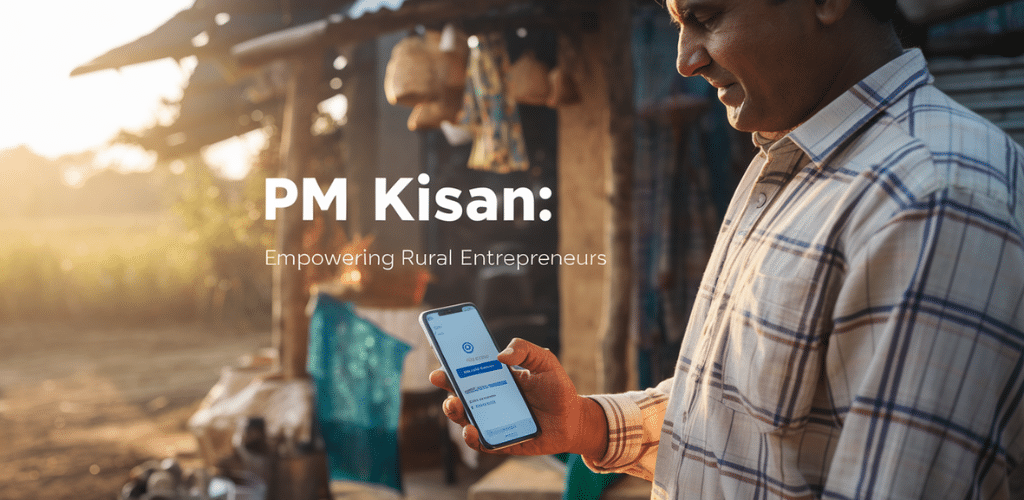In the heart of rural India, a quiet revolution is unfolding. Since February 2019, the Pradhan Mantri Kisan Samman Nidhi (PM-KISAN) has distributed over ₹3.24 lakh crore to more than 11 crore farmers, but its impact extends far beyond agriculture. What began as income support of ₹6,000 annually is now fueling something unexpected: a surge in rural digital entrepreneurship. With the 20th installment set to arrive in June 2025, farmers aren’t just investing in seeds and fertilizers—they’re launching online businesses and breaking free from generations of financial dependency.
The transformation is remarkable. Armed with regular installments delivered through Direct Benefit Transfer, rural Indians are investing in digital infrastructure and business growth rather than repaying high-interest loans from moneylenders. The program’s innovative digital tools—from the PM-KISAN mobile app to the AI-powered Kisan e-Mitra chatbot—aren’t just distributing funds; they’re creating digital literacy in villages previously untouched by technology. As we witness the 19th installment benefiting 9.8 crore farmers with over ₹22,000 crores, a new question emerges: How exactly is this agricultural support scheme becoming the unlikely hero of India’s rural digital economy?
In this post, we’ll explore how PM-KISAN has evolved from a simple farm support program to a catalyst for rural financial transformation, breaking dependency cycles, and powering online business growth across India’s countryside. We’ll examine how farmers are redirecting these funds from traditional agriculture to digital ventures, and what the future holds for this unexpected intersection of agricultural policy and entrepreneurship.
Table of Contents
PM Kisan Yojana: A Catalyst for Rural Financial Transformation

Overview of the Scheme: Structure, Eligibility, and Objectives
The PM Kisan Yojana isn’t just another government scheme—it’s a financial lifeline that’s changing the game for rural India. Launched in December 2018, this program has a straightforward mission: provide direct income support to all landholding farmer families across the country.
The structure is beautifully simple. Eligible farmers receive ₹6,000 annually, paid in three equal installments of ₹2,000 every four months. No complicated paperwork or middlemen—just direct support when farmers need it most.
Who qualifies? Initially, the scheme targeted small and marginal farmers with less than 2 hectares of land. But in June 2019, the government expanded it to include all landholding farmer families regardless of land size. That’s approximately 14.5 crore farming households!
There are some exclusions though:
- Institutional landholders
- Farmer families with members holding specific high-profile positions (like former/current ministers, MPs, etc.)
- Professional taxpayers (doctors, lawyers, etc.)
- Individuals with a monthly pension exceeding ₹10,000
The core objectives go beyond just financial aid:
- Income stabilization – Providing a safety net during crop failures or market fluctuations
- Financial inclusion – Bringing more farmers into the banking system
- Agricultural investment – Enabling farmers to purchase seeds, fertilizers, and equipment
- Rural economic stimulation – Injecting cash directly into rural economies
Direct Benefit Transfer: How ₹6,000 Annual Support Reaches Farmers
Gone are the days when government aid disappeared before reaching those who needed it most. PM Kisan cuts through the red tape with its Direct Benefit Transfer (DBT) system—a game-changer for rural India.
Here’s how the money flows:
- Registration – Farmers register through local agriculture officers or online portals
- Verification – State governments verify land records and eligibility
- Aadhaar linking – Farmer details are matched with Aadhaar for identity confirmation
- Bank account validation – Account details are verified through PFMS (Public Financial Management System)
- Direct transfer – Funds move straight from central government to farmer bank accounts
The beauty of this system? Transparency and efficiency. Every rupee allocated reaches the intended beneficiary—no leakage, no corruption, no delays.
Many farmers receive SMS alerts when money hits their accounts, creating a digital paper trail that builds trust in the system. This direct connection between government and farmer eliminates corruption opportunities that plagued previous aid programs.
Current Status: 19 Installments Completed with Over ₹3.24 Lakh Crore Disbursed
The numbers tell an impressive story. As of June 2025, the government has successfully released 19 installments under PM Kisan, pumping over ₹3.24 lakh crore directly into rural India’s economy.
The latest data shows approximately 11.37 crore farmers have received these benefits—creating perhaps the world’s largest direct benefit transfer scheme for agriculturists.
The state-wise distribution reveals interesting patterns:
| State | Beneficiaries (in crores) | Amount Disbursed (₹ in crores) |
|---|---|---|
| Uttar Pradesh | 2.54 | 51,089 |
| Maharashtra | 1.09 | 23,282 |
| Madhya Pradesh | 0.98 | 19,861 |
| Bihar | 0.78 | 16,756 |
| Rajasthan | 0.69 | 14,927 |
This massive cash infusion has created ripple effects throughout rural economies. Beyond just supporting farming activities, these funds have empowered farmers to become digital consumers and entrepreneurs, connecting rural businesses to the online marketplace in unprecedented ways.
Breaking the Cycle of Rural Debt and Dependency

Building upon the transformative financial impact of PM Kisan Yojana we discussed earlier, this section explores how the scheme has fundamentally altered the economic landscape for rural farmers across India. The program has become more than just financial assistance—it’s a powerful tool breaking generational cycles of debt and dependency.
Reducing Farmers’ Reliance on Moneylenders
The PM-KISAN Samman Nidhi Yojana, launched in February 2019, has created a significant shift in how farmers manage their financial needs. With the annual financial assistance of ₹6,000 disbursed directly to eligible farmers through Direct Benefit Transfer (DBT), many rural households now have a reliable alternative to predatory moneylenders.
This direct income support has proven crucial for farmers who historically had limited options for funding:
- The predictable installment structure (three payments of ₹2,000 annually) provides farmers with planned liquidity
- The DBT mechanism ensures funds reach farmers directly without intermediaries
- The most recent 19th installment in February 2025 demonstrates the program’s consistency and reliability
By providing this consistent financial support, PM Kisan has reduced the desperate need for high-interest emergency loans that often trapped farmers in cycles of debt. The program’s transparent and direct approach stands in stark contrast to traditional informal lending that has historically dominated rural finance.
Creating Financial Stability for Over 11 Crore Farmer Families
The scale of PM Kisan’s impact is remarkable, with benefits reaching more than 11 crore farmer families across India. This widespread coverage has created a new baseline of financial stability for a significant portion of rural India.
The program’s implementation has prioritized accessibility and inclusion:
- Mandatory e-KYC processes ensure proper identification of legitimate beneficiaries
- Multiple options for completing verification requirements (online portal, mobile app, or Common Service Centres)
- Special provisions for rural areas without internet access through CSCs
- Ongoing verification systems allowing farmers to check their beneficiary status
With the 20th installment expected in June 2025, these families continue to receive predictable support that helps stabilize household finances. This reliability is crucial for agricultural communities where income is often seasonal and unpredictable.
Case Study: IFPRI Research on PM Kisan’s Impact in Uttar Pradesh
Research conducted in Uttar Pradesh demonstrates the tangible effects of PM Kisan on breaking dependency cycles. The study revealed significant improvements in financial resilience among beneficiary families. Farmers are now empowered to make more strategic decisions about their agricultural practices and household expenditures.
Key findings from the research include:
- Increased ability to purchase farming inputs without credit
- Reduced reliance on informal loans with predatory interest rates
- Greater capacity to manage household expenses during lean agricultural periods
- Improved compliance with formal banking requirements, including Aadhaar-bank linkages
- Enhanced financial literacy as farmers navigate the PM-KISAN portal and verification systems
The study particularly highlights how the mandatory e-KYC process, while initially challenging for some farmers, has accelerated digital financial inclusion. Farmers now regularly check their status on the PM-KISAN portal and understand the importance of maintaining proper documentation and bank linkages.
As we explore in the next section on “Digital Infrastructure Powering Rural Business Growth,” this newfound financial stability is creating a foundation for entrepreneurial activities. The reduced dependency on high-interest loans means farmers can now consider investing portions of their PM Kisan funds into small online businesses and digital ventures, leveraging the growing rural digital infrastructure to diversify their income sources beyond traditional agriculture.
Digital Infrastructure Powering Rural Business Growth

Having broken free from the cycle of rural debt and dependency, farmers enrolled in the PM Kisan Yojana are now leveraging the scheme’s robust digital infrastructure to establish and grow online businesses. This digital transformation is occurring through various technological platforms that have been integrated into the PM Kisan framework.
PM Kisan Portal and Mobile App: Bringing Technology to Farmlands
The PM Kisan initiative has revolutionized how technology reaches India’s farmlands through its comprehensive digital ecosystem. At the heart of this system is the Direct Benefit Transfer (DBT) mechanism that delivers financial assistance directly to Aadhaar-linked bank accounts of eligible farmers. This digital money transfer system eliminates intermediaries, ensuring that all ₹6,000 of the annual support reaches the intended beneficiaries.
The PM Kisan portal and mobile application have become vital tools for rural farmers who represent 86% of India’s farming population. These platforms allow beneficiaries to check their status in the PM Kisan beneficiary list, track upcoming installments, and receive notifications about their payments. For rural entrepreneurs, this predictable income flow and digital accessibility have created a foundation upon which they can build sustainable online businesses.
The integration of e-Governance tools has significantly improved the efficiency and reach of the program, allowing even farmers in remote areas to participate in the digital economy. Many beneficiaries are using these platforms not just to receive benefits but as gateways to explore other digital services and business opportunities.
Kisan e-Mitra AI Chatbot: Multilingual Support for Rural Entrepreneurs
Recognizing the language barriers that exist across rural India, the government has implemented multilingual support systems including the Kisan e-Mitra AI Chatbot. This innovative solution addresses one of the key challenges mentioned in the program assessment: the digital divide affecting internet access and smartphone usage among farmers.
The AI chatbot provides support in multiple regional languages, allowing farmers from diverse linguistic backgrounds to access information about their benefits, eligibility criteria, and troubleshooting assistance. This multilingual approach has been crucial in empowering rural entrepreneurs who previously faced language barriers when attempting to navigate digital platforms.
For rural business owners, the chatbot serves as a virtual assistant that helps them understand how to leverage their PM Kisan benefits for business investment. It also guides them through various digital processes, enabling them to focus more on building their enterprises rather than struggling with technological challenges.
E-KYC Process: Streamlining Verification for Continuous Benefits
The implementation of electronic Know Your Customer (e-KYC) processes has significantly streamlined the verification procedures for PM Kisan beneficiaries. This digital verification system ensures continuous flow of benefits without repeated paperwork or physical verification requirements.
The e-KYC process uses Aadhaar-based authentication to verify beneficiaries’ identities, creating a secure and efficient system for benefit disbursement. This has been particularly valuable for rural entrepreneurs who need consistent financial support to maintain their business operations. The streamlined verification process reduces administrative burdens and allows farmers to focus on their agricultural and entrepreneurial activities.
However, the reference content highlights that challenges persist, such as discrepancies in land records leading to eligibility issues and potential cybersecurity threats. To address these concerns, the government has established Common Service Centers for improving digital literacy and continues to work on the digitization of land records to ensure accurate beneficiary identification.
As we move from discussing the digital infrastructure that powers rural business growth, we’ll next explore how PM Kisan has evolved from being merely a farm support scheme to becoming a catalyst for business investment in rural India. This transformation demonstrates how targeted financial assistance can create ripple effects throughout the rural economy, enabling farmers to diversify their income sources and build sustainable online businesses.
From Farm Support to Business Investment

Now that we’ve explored how digital infrastructure is transforming rural business landscapes, let’s examine how PM Kisan Yojana funds are being repurposed from basic farm support to catalyzing entrepreneurial growth in rural India.
How Farmers Are Converting Financial Aid into Entrepreneurial Ventures
The Pradhan Mantri Kisan Samman Nidhi (PM-KISAN) scheme has evolved beyond its initial purpose of providing basic financial support to farmers. The scheme’s direct benefit transfer (DBT) of Rs 6,000 annually, distributed in three installments of Rs 2,000 every four months, has created a reliable income stream that farmers can plan around. As of June 2025, with the upcoming 20th installment, many farmers have begun viewing these predictable payments not just as subsistence support but as potential investment capital.
The regular nature of these payments has allowed farmers to think beyond immediate consumption needs. With a guaranteed Rs 2,000 arriving every four months, many beneficiaries are pooling these funds over multiple cycles to accumulate enough capital to launch small online businesses. The direct transfer to bank accounts has familiarized millions of rural Indians with formal banking, creating a foundation for more sophisticated financial planning and investment behaviors.
Agricultural Inputs: Investing in Equipment, Seeds, and Fertilizers
One of the most direct ways PM Kisan funds are supporting rural business growth is through strategic investments in agricultural inputs. Farmers are increasingly combining multiple installments to purchase higher-quality seeds, fertilizers, and small equipment that they previously couldn’t afford. This strategic reinvestment has helped improve crop yields and quality, generating additional income that can be further channeled into business development.
The PM-KISAN portal and registration process, which requires farmers to provide their bank account information, IFSC/MICR codes, and complete e-KYC verification, has created a digital paper trail that helps farmers build credit histories. This formal financial footprint enables them to leverage their PM Kisan participation to access additional credit for larger agricultural investments, creating a virtuous cycle of investment and returns.
The Multiplier Effect: How PM Kisan Funds Circulate in Rural Economies
The impact of PM Kisan extends far beyond individual beneficiaries. The scheme, which recently reached approximately 9.8 crore farmers with its 19th installment, has injected significant liquidity into rural economies. Each Rs 2,000 installment multiplies as it circulates through local markets, benefiting not just farmers but also rural businesses, service providers, and digital entrepreneurs.
This multiplier effect is particularly evident in the growth of rural e-commerce and digital service providers. As farmers invest in smartphones and internet connectivity to complete their PM Kisan e-KYC requirements (either through Aadhaar-based OTP or biometric verification at Common Service Centres), they gain access to online marketplaces where they can both purchase agricultural inputs and sell their produce directly to consumers, bypassing traditional middlemen and capturing more value.
The exclusion criteria of the scheme—which prevents those holding constitutional positions, government employees, professionals like doctors and engineers, and those earning substantial pensions or paying income tax from receiving benefits—ensures that funds are directed to those who are most likely to reinvest them locally, strengthening rural economic ecosystems.
With this financial foundation in place, we’re seeing the emergence of a new generation of rural digital entrepreneurs who are using PM Kisan funds as seed capital for more ambitious ventures. As we look toward the future of PM Kisan and rural digital entrepreneurship, we’ll explore how these initial investments might scale into sustainable businesses that could transform India’s rural economy for decades to come.
The Future of PM Kisan and Rural Digital Entrepreneurship

Now that we’ve examined how PM Kisan funds are being repurposed from basic farm support to business investments, let’s explore the exciting future trajectory of this transformative scheme and its impact on rural digital entrepreneurship.
Upcoming 20th and 21st Installments: What Farmers Can Expect in 2025
As we move further into 2025, the 20th and 21st installments of the PM Kisan Yojana promise significant developments for rural entrepreneurs. Building on the foundation established since its launch in February 2019, these upcoming installments are expected to maintain the ₹6,000 annual financial assistance divided into three equal parts. What makes these particular installments noteworthy is their enhanced integration with digital systems.
Beneficiaries in the PM Kisan beneficiary list can anticipate:
- Improved Direct Benefit Transfer (DBT) mechanisms with faster processing times
- Enhanced mobile notifications through the PM Kisan app
- Streamlined verification processes through Aadhaar-linked accounts
- Greater transparency in disbursement tracking
These improvements aim to further strengthen the income security provided to over 11 crore farmers, particularly benefiting those who have leveraged previous installments to establish online businesses.
Integration with Other Digital Public Infrastructure
The PM Kisan Yojana’s future is closely tied to its integration with India’s expanding digital public infrastructure. This integration represents a significant leap forward in creating a comprehensive ecosystem for rural digital entrepreneurship.
Key integration points include:
- Aadhaar-Based Systems: Further refinement of Aadhaar-linked bank accounts to ensure seamless fund transfers while maintaining security
- E-Governance Tools: Enhanced connectivity with other government platforms to provide rural entrepreneurs with a unified digital experience
- Mobile Applications: Expansion of multilingual mobile app support to bridge the digital divide affecting internet access
- Advanced Technologies: Potential implementation of AI, IoT, and Blockchain technologies to create a more inclusive and efficient system
This digital integration aims to address current challenges like digital literacy gaps and enhance the efficiency of fund utilization for business development among rural beneficiaries.
Addressing Challenges: Ensuring 100% Coverage and Grievance Resolution
Despite the significant impact of the PM Kisan Yojana, several challenges persist that need addressing to maximize its potential for rural digital entrepreneurship:Digital Divide Challenges:
- Limited internet access in remote areas
- Variable smartphone adoption rates among farmers
- Digital literacy gaps among potential beneficiaries
Administrative Challenges:
- Discrepancies in land records leading to eligibility issues
- Potential cybersecurity threats as the program scales
- Grievance resolution timeframes
To overcome these challenges, the government has initiated several measures:
- Establishing more Common Service Centers to improve digital literacy
- Accelerating the digitization of land records to resolve eligibility issues
- Implementing robust cybersecurity measures to protect beneficiaries’ data
- Creating specialized grievance resolution mechanisms with shorter turnaround times
These initiatives align with various Sustainable Development Goals by reducing rural poverty, enhancing economic growth, and creating a more inclusive digital ecosystem for rural entrepreneurs.
As we move forward, the PM Kisan Yojana’s evolution from a simple income support scheme to a catalyst for rural digital entrepreneurship showcases its adaptability and long-term vision. With these developments in place, let’s address some frequently asked questions about how farmers can best leverage this scheme for their online businesses.
FAQ’s
Now that we’ve explored the transformative potential of PM Kisan Yojana for rural digital entrepreneurship, let’s address some of the most common questions about this influential scheme.
A. What Is PM Kisan Yojana?
PM Kisan Samman Nidhi (PM-KISAN) is a government initiative launched by the Indian government designed to provide direct financial assistance to farmer families across India. Under this scheme, eligible farmers receive an annual benefit of ₹6,000, which is distributed in three equal installments of ₹2,000 every four months.
The scheme was initially introduced for small and marginal farmers but has since been expanded to include all farmer families regardless of the size of their landholdings. This expansion reflects the government’s commitment to supporting India’s agricultural community more comprehensively.
To maintain eligibility for upcoming installments, including the 12th installment, beneficiaries must ensure their KYC (Know Your Customer) details are up-to-date in the system. This verification process helps maintain the integrity of the pm kisan beneficiary list and ensures funds reach the intended recipients.
The program operates with specific eligibility criteria:
- Farmers must possess cultivable land in their name
- The land must be actively farmed and not used for non-agricultural purposes
- Tenants or those cultivating family-owned land without legal ownership are not eligible
- Institutional landholders, certain government officials, and income tax payers are excluded
B. What is the purpose of PM KISAN Yojana?
The primary purpose of the PM KISAN Yojana is to enhance the financial stability of farmer families throughout India. By providing regular income support, the scheme aims to help farmers meet both their agricultural and domestic expenses more effectively.
This financial assistance serves multiple important functions:
- Financial Security: The ₹6,000 annual support provides a reliable income stream that farmers can count on regardless of crop yield or market fluctuations.
- Breaking Dependency Cycles: The direct financial support helps reduce farmers’ reliance on informal lending systems that often charge exorbitant interest rates.
- Agricultural Investment: With guaranteed payments, farmers can better plan and invest in their agricultural operations, including necessary inputs like seeds, fertilizers, and equipment.
- Digital Financial Inclusion: The scheme utilizes direct bank transfers for disbursement, which necessitates farmers having active bank accounts, thereby promoting financial inclusion in rural areas.
- Transparency: The program maintains transparency through public beneficiary lists displayed at local Panchayats, allowing for community oversight.
- Digital Communication: Beneficiaries receive notifications via SMS regarding benefit sanctions, helping them stay informed about their payment status.
The implementation of PM KISAN requires farmers to submit essential information, including their Aadhaar number, to verify their identity and establish eligibility. The emphasis on accurate bank details ensures that the financial support reaches the intended beneficiaries efficiently.
As we’ve seen throughout this article, beyond these immediate purposes, PM KISAN has also contributed significantly to powering rural online businesses by providing the capital foundation that many farmers need to diversify into digital entrepreneurship.
Conclusion
The Power of PM Kisan in Digital Rural India
As we’ve explored throughout this blog, PM Kisan Yojana has evolved beyond its original scope of agricultural support to become a catalyst for rural digital entrepreneurship. With over ₹3.24 lakh crore disbursed to more than 11 crore farmers since its inception in 2019, the scheme has broken the cycle of debt dependency while creating a foundation for online business ventures. The timely installments of ₹6,000 annually have provided rural entrepreneurs with the capital needed to invest in digital infrastructure and business development.
The future of rural India lies at this intersection of agricultural support and digital innovation. As the 20th installment approaches in June 2025, farmers-turned-entrepreneurs continue to leverage these funds to expand their online presence. The government’s integration of digital tools like the PM Kisan mobile application, e-KYC processes, and the AI-powered Kisan e-Mitra chatbot further demonstrates its commitment to building a digitally empowered rural economy. By continuing to support initiatives that bridge the urban-rural digital divide, we can ensure that India’s agricultural heartland becomes equally competitive in the digital marketplace, creating a truly self-reliant Bharat.







